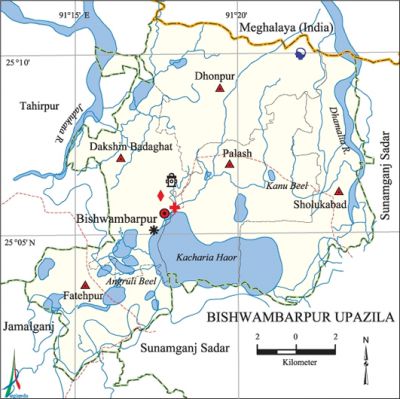Bishwambarpur Upazila
Bishwambarpur Upazila (sunamganj district) area 127.76 sq km, located in between 25°01' and 25°11' north latitudes and in between 91°12' and 91°24' east longitudes. It is bounded by Meghalaya State of India on the north, sunamganj sadar and jamalganj upazilas on the south, Sunamganj Sadar upazila on the east, tahirpur and Jamalganj upazilas on the west.
Population Total 126259; male 63458, female 62801; Muslim 109860, Hindu 16276, Buddhist 62,' and others 61. Indigenous communities such as hajong, garo, manipuri belong to this upazila.
Water bodies Main rivers are Dhamalia, Jadukata; Kacharia Baor, Zamirtala Beel, Angruli Beel and Kanu Beel are notable.
Administration Bishwambarpur Thana was formed in 1979 and it was turned into an upazila in 1983.
| Upazila | ||||||||
| Municipality | Union | Mouza | Village | Population | Density (per sq km) | Literacy rate (%) | ||
| Urban | Rural | Urban | Rural | |||||
| - | 5 | 59 | 183 | 3206 | 123053 | 988 | 50.5 | 27.8 |
| Upazila Town | ||||||||
|
Area (sq km) |
Mouza |
Population |
Density (per sq km) |
Literacy rate (%) | ||||
|
5.48 |
1 |
3206 |
585 |
50.49 | ||||
| Union | ||||||||
| Name of Union and GO Code | Area (sq km) | Population | Literacy rate (%) | |||||
| Male | Female | |||||||
|
Dakshin Badaghat 17 |
7403 |
9395 |
9365 |
24.66 | ||||
|
Dhonpur 20 |
10410 |
15658 |
15808 |
23.89 | ||||
|
Palash 77 |
2594 |
1735 |
1701 |
33.46 | ||||
|
Fatehpur 34 |
9776 |
12052 |
11576 |
37.41 | ||||
|
Sholukabad 80 |
1759 |
2114 |
2029 |
23.07 | ||||
Source Bangladesh Population Census 2001, Bangladesh Bureau of Statistics.

Religious institutions Mosque 203, temple 61, church 1, tomb 2. Noted religious institutions: Palash Jami Mosque.
Literacy rate and educational institutions Average literacy 28.4%; male 32.3% female 24.5%. Noted educational institutions: Digendravarman College (1992), Satgaon High School (1923), Fatehpur Murari' Chand High School (1937), Palash High School (1962), Bishwambarpur High School (1972), Katakhali Public High School, Sahapur Govt. Primary School (1905), Bishwambarpur Ideal Govt. Primary School (1928).
Main sources of income Agriculture 72.11%, non-agricultural labourer 6.23%, industry 0.31%, commerce 8.32%, transport and communication 0.93%, service 2.15%, construction 0.37%, religious service 0.28%, rent and remittance 0.30% and others 9%.
Ownership of agricultural land Landowner 52.46%, landless 47.54%; agricultural landowner: urban 57.52% and rural 52.34%.
Main crops Paddy, wheat, vegetables.
Extinct or nearly extinct crops Jute, kaun, tobacco.
Main fruits Mango, jackfruit, banana, papaya, lemon.
Fisheries, dairies and poultries This upazila has a number of fisheries, dairies and poultries.
Communication facilities Pucca road 27 km, mud road 221 km.
Extinct or nearly extinct traditional transport Palanquin, bullock cart.
Cottage industries Goldsmith, blacksmith, Bamboo work, cane work.
Hats, bazars and fairs Hats and bazars are 23, fairs 2. Bishwambarpur Bazar, Chinakandi Bazar, Dhonpur Bazar, Bagber Bazar, Sharupganj Bazar, Katakhali Bazar and Badamghat Bazar are notable.
Main exports Rich, fish, limestone.
Access to electricity All the unions of this upazila are under rural electrification net-work; However, 2.82% dwelling households have access to electricity.
Natural resources Fish, sand and limestone.
Sources of drinking water Tube-well 76.01%, pond 3.49%, tap 1.10% and others 19.40%.
Sanitation 9.64% (urban 44.08% and rural 8.84%) of dwelling households of the upazila use sanitary latrines and 71.62% (urban 47.43% and rural 72.18%) of dwelling households use non-sanitary latrines; 18.74% of households do not have latrine facilities.
Health centres Upazila health centre 1, family planning centre 3.
Natural disasters The earth quake of 1897 and the tsunami of 2004 caused huge loss of life and damage to settlements, crops, livestock and other properties of the upazila.
NGO activities brac. [Jayanta Singh Roy]
References Bangladesh Population Census 2001, Bangladesh Bureau of Statistics; Cultural survey report of Bishwambarpur Upazila 2007.
